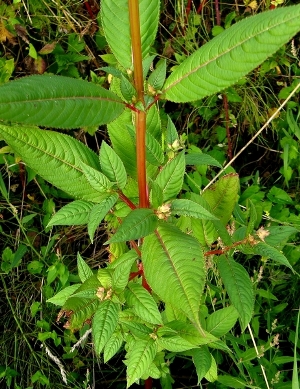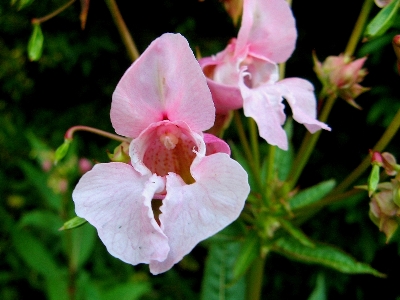Impatiens glandulifera Royle (syn.: I. roylei Walp.) (Himalayas) – A commonly naturalised and much extending escape from cultivation (although still rare in some parts of Belgium, for instance in Limburg; see Verloove 2006). First recorded in 1891 along river Zenne and soon afterwards (1895) along riverlet Haine. Probably first established in the valley of river Dijle from the 1920’s onwards, subsequently also around Brussel (Zoniënwoud). A wider naturalisation apparently started in the 1940’s and 1950’s. Initially it was confined to the larger river valleys but recently increasingly proliferating in other wet habitats (ditches, damp meadows, etc.). By now, Impatiens glandulifera has become an invasive environmental weed in riparian habitats. Its populations are monitored and controlled in several nature reserves, especially along river Schelde in Flanders but also in Wallonia (Saintenoy-Simon 2008).
Additional information on the invasive behaviour of Impatiens glandulifera in Belgium and the Netherlands is available at: http://ias.biodiversity.be/species/show/65 and http://www.q-bank.eu/Plants/BioloMICS.aspx?Table=Plants%20-%20Species&Re....


Selected literature:
There is a vast literature on the spread of Impatiens glandulifera in Europe and on its invasive behaviour. A recent overview is provided by Hejda & Pyšek (2006).
Adolphi K. (1995) Neophytische Kultur- und Anbaupflanzen als Kulturflüchtlinge des Rheinlandes. Nardus 2: 272 p.
Duvigneaud J. (1979) La basse vallée du Bocq (province de Namur, Belgique). Nouvelles notes floristiques. Nat. Mosana 32: 175-184.
Hejda M. & Pyšek P. (2006). What is the impact of Impatiens glandulifera on species diversity of invaded riparian vegetation? Biol. Conserv. 132 (2): 143-152. [available online at: http://www.parkpruhonice.cz/personal/pysek/pdf/Hejda,%20Pysek-Impatiens%20impact_BiolConserv2006.pdf]
Holzner W. (1971) Verbreitung und Vergesellschaftung von Impatiens glandulifera an der Leitha. Mitteilungen der Botanischen Arbeitsgemeinschaft am Öberösterreichischen Landesmuseum Linz 3: 45-50.
Kasperek G. (2004) Fluctuations in numbers of neophytes, especially Impatiens glandulifera, in permanent plots in a west German flooodplain during 13 years. Berlin: Biological invasions: challenges for science. [available online at: http://user.uni-frankfurt.de/~kasperek/papers/kasperek_2004_fluctuations.pdf]
Kurtto A. (1996) Impatiens glandulifera (Balsaminaceae) as an ornamental and escape in Finland, with notes on the other Nordic countries. Symb. Bot. Upsal. 31(3): 221-228.
Lhotská M. & Kopecký K. (1966) Zur Verbreitungsbiologie und Phytozönologie von Impatiens glandulifera Royle an den Flußsystemen der Svitava, Svaratka und oberen Odra. Preslia 38: 376-385.
Pfeiffenschneider M., Gräser P. & Ries C. (2014) Distribution of selected neophytes along the national railway network of Luxembourg. Bulletin de la Société des naturalistes Luxembourgeois 115: 95-100. [available online at: http://www.snl.lu/publications/bulletin/SNL_2014_115_095_100.pdf]
Pfeiffenschneider M., Gräser P. & Ries C. (2014) Distribution of selected neophytes along the main rivers of Luxembourg. Bulletin de la Société des naturalists Luxembourgeois 115: 101-108. [available online at: http://www.snl.lu/publications/bulletin/SNL_2014_115_101_108.pdf]
Presland J. (2010) Indian Balsam - triffid or treat? BSBI News 115: 60-68. [available online at: http://archive.bsbi.org.uk/BSBINews116.pdf]
Pyšek P. & Prach K. (1995a) Historicky prehled lokalit Impatiens glandulifera na uzemi Ceske republiky a poznamky k dynamice jeji invaze. Zpr. Čes. Bot. Společ. 29: 11-31.
Pyšek P. & Prach K. (1995b) Invasion dynamics of Impatiens glandulifera ― a century of spreading reconstructed. Biol. Conserv. 74: 41-48.
Schmidt P. (1976) Das drüsige Springkraut (Impatiens glandulifera ROYLE), ein flußbegleitender Neophyt in Ostthüringen. Mitteilungen zur floristischen Kartierung Halle 2: 34-40.
Schmitz G. (1991) Nutzung der Neophyten Impatiens glandulifera Royle und Impatiens parviflora DC. durch phytophage Insekten im Raum Bonn. Entomologische Nachrichten und Berichte 35(4): 260-264.
Schuldes H. (1996) Das Indische Springkraut (Impatiens glandulifera): Biologie, Verbreitung, Kontrolle. Beiträge der Akademie für Natur- und Umweltschutz Baden-Württemberg 22: 29-35.
Szameitat H.D. (1989) Impatiens glandulifera Royle als Bachbegleiter in Ostmecklenburg. Botanischer Rundbrief für den Bezirk Neubrandenburg 21: 33-36.
Verloove F. (2002) Ingeburgerde plantensoorten in Vlaanderen. Mededeling van het Instituut voor Natuurbehoud n° 20: 227 p.
Verloove F. (2006) Impatiens glandulifera. In: Van Landuyt W., Hoste I., Vanhecke L., Van den Bremt P., Vercruysse W. & De Beer D., Atlas van de flora van Vlaanderen en het Brussels gewest. Instituut voor Natuur- en Bosonderzoek, Nationale Plantentuin van België en Flo.Wer: 491.

